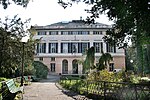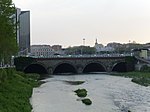AON Open Challenger
2003 establishments in ItalyAON Open ChallengerATP Challenger TourClay court tennis tournamentsRecurring sporting events established in 2003 ... and 2 more
Sports competitions in GenoaTennis tournaments in Italy
The Genoa AON Open Challenger - Memorial Giorgio Messina is an annual tennis tournament held in Genoa, Italy, usually in September, since 2003. The event is part of the ATP challenger series and is played on outdoor clay courts. The tournament has been organized annually since 2003, with the sole exceptions of 2020 and 2021, when it was canceled because of the worldwide COVID-19 pandemic. The 2022 edition is the 18th tournament of the series.
Excerpt from the Wikipedia article AON Open Challenger (License: CC BY-SA 3.0, Authors).AON Open Challenger
Giardini Carlo Alberto Dalla Chiesa, Genoa Albaro
Geographical coordinates (GPS) Address Nearby Places Show on map
Geographical coordinates (GPS)
| Latitude | Longitude |
|---|---|
| N 44.3975 ° | E 8.9624 ° |
Address
Stadio Beppe Croce
Giardini Carlo Alberto Dalla Chiesa
16146 Genoa, Albaro
Liguria, Italy
Open on Google Maps










